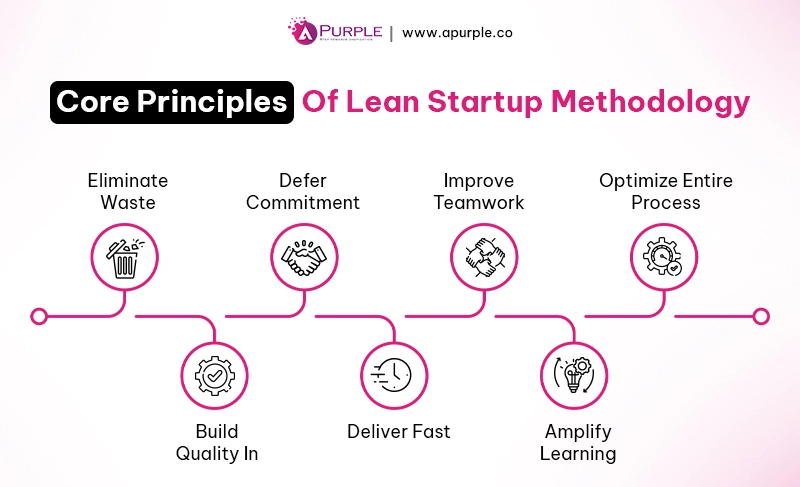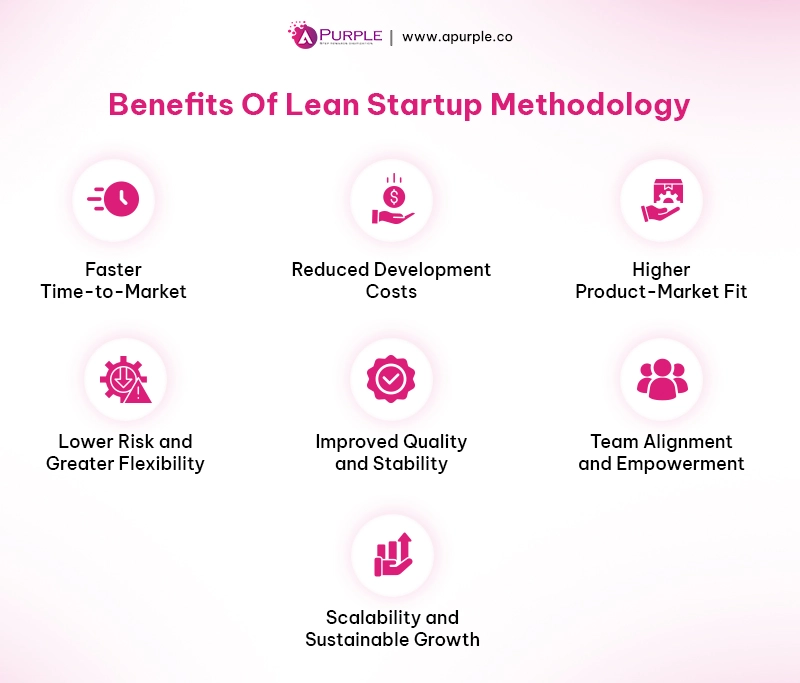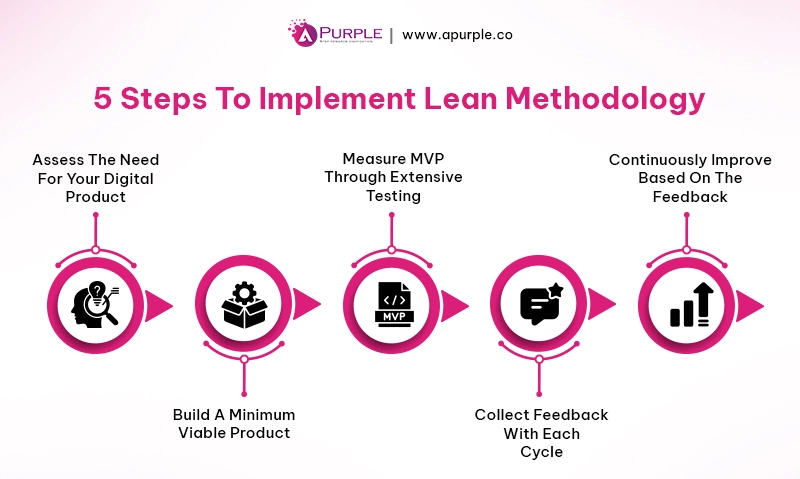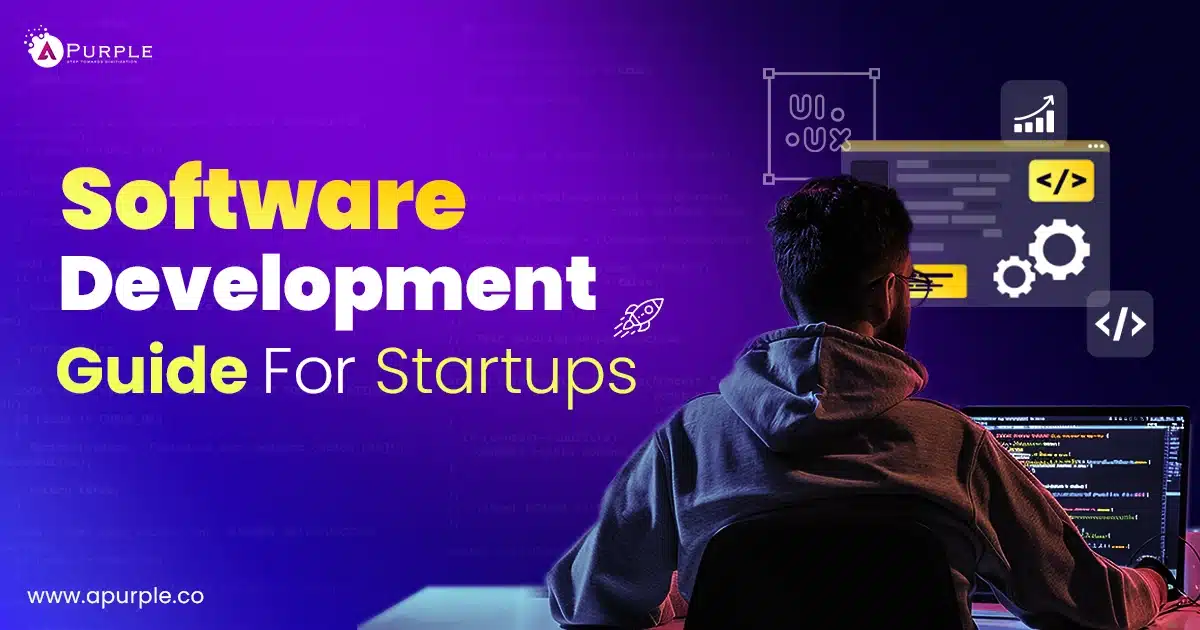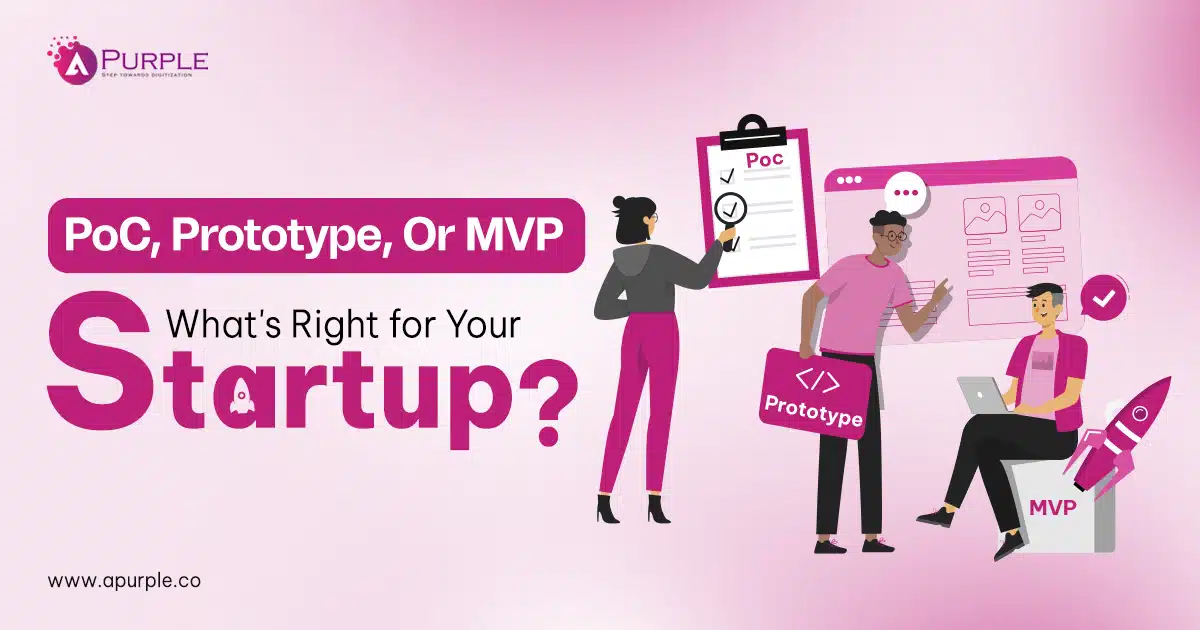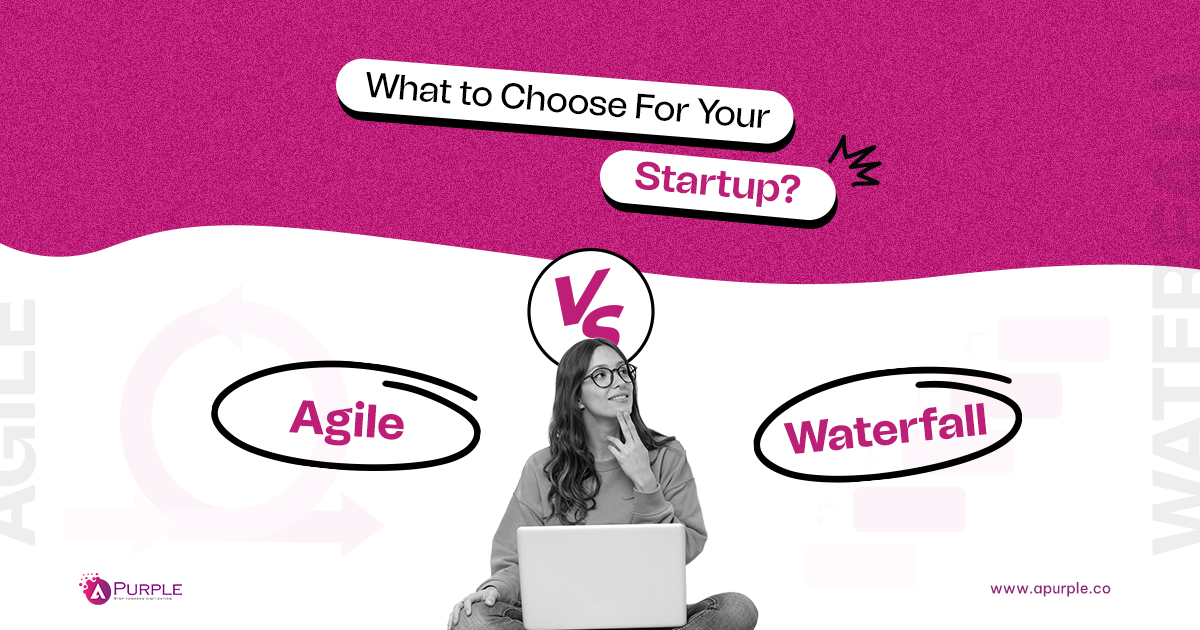Got a startup idea?
How do you bring it to life without wasting time, money, or momentum?
The traditional approach is to create a pitch deck, find funding, assemble the right team, and go for a full launch. But it often leads to failure. Not because the idea was bad, but because there was no real way to validate product-market fit.
That’s where the Lean Startup Methodology comes in.
It helps you build smarter, not bigger. Instead of developing a “perfect” product upfront, you launch a lean version fast, test it with real users, collect insights, and iterate based on what works.
So, what is lean startup methodology, and how can it be used?
Whether you’re an aspiring entrepreneur validating your app idea or a startup founder navigating pivots or scale, this guide is your blueprint. It will help you understand lean startup methodology, its core principles, benefits, and key implementation steps.
Let’s first understand lean startup methodology and how you can use it to validate your idea.
What Is Lean Startup Methodology?
Lean startup methodology is an approach to building products using rapid experimentation, validated learning, and iterative development. It allows you to build a minimum viable product(MVP), test it, collect customer feedback, and continuously improve.
First introduced by Eric Ries in the 2011 book The Lean Startup, it involves creating a minimum viable product (MVP) to validate a startup’s ideas quickly. The core idea behind the lean startup methodology is to “fail fast.” So, if you are an entrepreneur with a startup idea, you build an MVP and test it for failure. This allows you to pivot quickly if the idea fails or refine it.
Eric Ries introduced the lean startup methodology based on the Japanese production approach during World War 2- “Toyota Production System (TPS).”
Why Consider Lean Startup Compared To A Traditional Startup Approach?
Apart from the customer involvement, the traditional startup approach also differs in the speed at which the product is built and tested. Other key differences are,
| Differentiators | Lean Startup Methodology | Traditional Startup Approach |
|---|---|---|
| Development Philosophy | Idea validation through rapid experimentation and customer feedback | In-depth upfront planning and execution based on a fixed project scope |
| Development Flow | Build an MVP fast, iterate continuously | Develop a full-fledged startup app before the launch. |
| Process | Build, measure, learn loop process | Linear and sequential development process |
| Customer Involvement | Customers are the early adopters of the digital product | Customers access the product only after the launch |
| Risk Management | Reduced risk due to continuous validations and improvements | Higher risk due to massive upfront |
| Time to Market | Faster | Slower |
| Resource Allocation | Incremental and minimizes waste | Higher upfront resource allocation |
| Flexibility | Highly flexible and adaptable | Rigid and sudden changes are costly. |
| Best For | New markets and startup business models | Established markets with proven business models |
The lean startup approach differs on multiple levels from the traditional method due to its core principles.
What Are The Main Principles Of The Lean Startup Methodology?
Core lean startup principles to develop an app include reducing waste, amplifying learning, deferring commitment, building quality, delivering fast, and fostering communication. These principles give your startup higher efficiency, value delivery, and continuous improvements.
Here are the key principles of the lean startup methodology that you can use,
- Eliminate Waste– Remove unnecessary features, defective functionalities, repeating test/fix cycles, or delayed integrations from your app that do not add value for customers.
- Build Quality In– Integrate quality assurance throughout the development cycle in processes like automated testing, code reviews, and CI/CD pipelines for each iteration.
- Amplify Learning– Use MVPs, A/B testing, and real-time analytics to gather user insights and adjust development based on real usage, not assumptions.
- Defer Commitment– Avoid making irreversible decisions early in the development process. Use flexible architectures, modular code, and incremental development.
- Deliver Fast– Speed up delivery through small, frequent iterations using agile app development, which reduces the time needed for new features to reach users.
- Improve Teamwork– Foster collaboration, cross-functional communication, and accountability to empower your app development team.
- Optimize Entire Process– Instead of optimizing individual components (like front-end performance or back-end scalability), consider optimizing the entire app lifecycle and user journey.
Applying these principles offers multiple benefits, including improved time to market, reduced costs, and a higher product-market fit.
What Are The Benefits Of Lean Startup Methodology?
Lean startup methodology provides multiple benefits, including reduced risks, faster development, lower cost, better alignment with project goals, and sustainable growth.
Key benefits of using the lean startup method
1. Faster Time-to-Market
In a competitive market, timing is everything. The best startup ideas can fail if not implemented at the right time. With quicker development, testing, and an iterative lean startup approach, you can shorten time-to-market.
2. Reduced Development Costs
The lean startup process involves reducing waste, which helps cut costs and optimize quality. Development is done in smaller iterations, so fewer resources are needed, reducing the overall cost.
3. Higher Product-Market Fit
Continuous feedback loops ensure you build what users need. Lean startup methodology enables data-driven decision-making. This leads to apps that solve real problems and provide better product-market fit.
4. Lower Risk and Greater Flexibility
Using MVP in mobile app development with the lean startup model, you can validate your idea and add new features per the changing market. Plus, lean methodology also offers a continuous development approach where you get the flexibility of adding features as per market requirements.
5. Improved Quality and Stability
Honestly, no user likes a crashing, unstable app! The lean startup approach helps you maintain quality throughout the development lifecycle. Each iteration is tested for quality and stability, ensuring a smoother user experience.
6. Team Alignment and Empowerment
Lean methodology promotes cross-functional teams and collaborations for faster decision-making. So, you don’t need to wait for approvals on each design, build, or testing iteration.
7. Scalability and Sustainable Growth
The entire build-measure-learn loop in lean startup models ensures higher scalability. You can scale your apps to new markets, release smaller iterations, and take continuous feedback from the target audience. This leads to sustainable growth for your startup.
Lean startup methodology offers benefits not just for your new venture but specifically to you as an entrepreneur!
How Does Lean Startup Methodology Help Entrepreneurs?
Using the lean startup approach, entrepreneurs can,
- Quickly test the startup idea and business model, and get real data to strengthen the investor pitch.
- Use MVPs to gather rapid feedback and refine offerings to match customer needs.
- Minimize the upfront investments through validation of ideas before scaling.
- Focus on building apps that solve users’ problems without investing in non-essential features.
- Pivot swiftly if the concept does not fit the market requirement before investing time and money
- Shorten the development cycles to ensure faster launches and amplified learning
- Continuously improve the apps, ensuring they evolve as the customer demands evolve.
Now that you know the benefits of lean startup methodology, it’s time to implement it.
How To Implement Lean Methodology For Your Startup: A Step-by-Step Process
Implementing the lean startup methodology includes identifying the need for a digital product, building MVPs, testing them, and learning from customer feedback.
Here are the key steps to the implementation of the lean startup process.
Step 1: Assess The Need For Your Digital Product
A major startup mistake that entrepreneurs make is not assessing their ideas enough. So, if you want your venture to succeed, evaluate if it’s needed.
So, how do you assess the need?
- Identify the real problem your product solves for users.
- Define specific target audience (Don’t serve everyone!)
- Estimate the market size for measuring the demand
- Analyze the existing competitors and alternative solutions
The above process is just the beginning. Implementing lean startup methodology further will help you validate the idea.
Pro Tip: Assess the customer profile and ensure your target audience is willing to pay for your product.
Step 2: Build A Minimum Viable Product
The needs assessment does not end at competitor analysis. You need to validate whether the app is usable and user-acceptable. Using MVPs, you can create a smaller app version that users can access and provide feedback on. Plus, it will allow you to test the idea quickly without a significant upfront investment.
Pro Tip: Align your MVPs with the idea validation goals and aim to reduce waste. Leverage MVP development services to ensure you don’t waste resources on non-essential features.
Step 3: Measure MVP Through Extensive Testing
Measuring the MVP lets you track your app’s performance and collect customer feedback data. Here is how to measure MVPs,
- Use landing pages to understand the market demand, track signups, pre-orders, and other conversion actions.
- Conduct A/B testing to compare different versions of features.
- Deploy social media polls and targeted feedback on specific MVP features
- Measure user interactions with the MVPs through heat maps.
- Track metrics like conversion rates, bounce rates, time on page, and user engagement
Pro Tip: To prioritize MVP improvements, combine customer behavioral analytics, such as user engagement and task completion rates, with direct user feedback.
Step 4: Collect Feedback With Each Cycle
Collecting feedback is one of the significant steps in the lead startup cycle, which helps you understand customer needs and expectations. Here is how you can gather feedback effectively for each lean startup cycle.
- Use artificial intelligence to process and analyze app usage data, support chats, and social media sentiment.
- Implement systems that maintain communication with users during the entire cycle.
- Gather data from multiple digital touchpoints across the app to optimize value propositions.
- Deploy interactive prototypes or demos to collect in-depth behavioral data.
Pro Tip: Build trust by immediately taking action on the feedback and publicly communicating with your customers.
Step 5: Learn From The Feedback And Continuously Improve
Once you gather customer feedback, it’s time to learn from the insights and fine-tune the app for continuous improvements.
Here is how you can ensure continuous improvements using the feedback insights,
- Analyze quantitative data like conversion rates, user retention, and engagement.
- Assess the qualitative feedback from customers, like user comments on social media interactions.
- Use the feedback data to make critical decisions to make structured changes to the app or continue refining it.
- Document all the learnings from each cycle to ensure the same mistakes are not repeated.
- Repeat the build-measure-learn loop quickly, ensuring faster cycles and improved learning.
Pro Tip: Use the “Getting Out of the Building” (GOOB) approach and engage with customers in their environment to better understand their needs and validate product ideas.
Implementing lean startup methodology offers several benefits, but it also has challenges that entrepreneurs need to understand.
What Are The Common Challenges And Pitfalls Of Implementing The Lean Startup Methodology?
Entrepreneurs often face challenges with implementing lean startup methodologies, such as overreliance on metrics, lack of long-term vision, and inadequate strategic planning.
Other key challenges and pitfalls are,
| Challenge | Cause | Solution |
|---|---|---|
| Slow Build-Measure-Learn Cycles | Highly complex MVPs or slower feedback loops | Build leaner MVPs and use AI to ensure rapid feedback analysis |
| Over-Reliance On Metrics | Tracking irrelevant or misleading metrics | Consult with startup experts to define metrics that align with your venture’s goals. |
| Unclear Goals | Building MVPs without defining clear goals | Ensure clarity while defining the expected outcomes before building MVPs |
| Ignoring Customer Feedback | Too focused on the founder’s intuition to ignore the user’s feedback | Prioritize continuous customer feedback collection and analysis at each stage. |
| Failing To Pivot When Needed | Attachment to the idea can lead to decision creep. | Leverage data-driven decision-making. |
| Resource Drain From Endless Iterations | Lack of clear learning objectives and optimal resource allocation | Set clear milestones and allocate resources accordingly |
| Scaling Too Soon | Scaling the features before achieving product-market fit | Validate product market fit backed by reliable data, and then scale. |
Overcoming these challenges requires a strategic lean startup approach focusing on customer feedback and quickly adapting.
What Are The Best Practices For Implementing The Lean Startup Methodologies?
Best practices to implement the lean startup method include creating a business model canvas, developing a leaner MVP, and emphasizing validated learning.
Key best practices to follow while implementing the lean startup approach are,
- Use the business model canvas to map out key components of your business, such as customer segments, value proposition, and different challenges, to clarify assumptions.
- Build leaner MVPs to ensure better speed to market, prioritizing the essential features that address the main customer problem.
- Ensure emphasis on the validated learning through continuous feedback collection and analysis.
- Iterate frequently based on customer feedback to refine your app’s performance and user experience.
- Use agile methodologies to ensure continuous delivery and improvements for your app.
- Practice innovation accounting by focusing on the actionable, accessible, and auditable insights for decision-making.
- Continuously review and adapt lean startup strategies to ensure your app keeps up with the changing customer demands.
Apart from the above best practices, one key tip for your startup is to add customers as co-creators.
How Customer Co-Creation Is Evolving Lean Product Development?
Customer co-creation transforms lean product development by directly involving users in the design and development. It ensures faster iterations but is customer-focused, ensuring your venture does not struggle with product-market fit issues.
Here is how you can leverage customer co-creation in lean product development.
- Use proactive, two-way collaborations with dynamic dialogue between your teams and customers.
- By integrating co-creation in the iterative process, you can validate the ideas quickly, reduce waste, and deliver features that matter.
- Higher customer involvement means closely aligned digital products that cater to customer needs.
- Co-creation encourages community building around digital products.
Involving customers throughout the leap startup cycle allows faster innovation and offers a competitive edge. However, you must be clear on the lean startup methodology to avoid misconceptions.
What Are The Lean Startup Myths and Misconceptions? (Debunking Them)
Here are some of the top myths about lean startup methodologies and the truth that debunks them.
| Myth | Truth |
|---|---|
| Lean means cheap or missing the big picture | The lean startup model is about speed, learning, and validated growth, not just cost-cutting. |
| MVP means low quality | MVP does not mean low quality, but early validation of an app that needs to be functional and provide core value to customers. |
| Lean methodology is only for tech startups | Lean startup principles can be applied to any industry. |
| Lean replaces vision with feedback. | The lean approach is a vision-driven method that uses feedback to validate it. |
| Lean is all about failures | Lean startup methodologies are all about learning from failures. |
Clearing misconceptions will help you plan your lean startup implementations. Before planning the entire cycle, you can analyze examples of lean methodology further.
What Are The Real-World Lean Methodology Examples?
Some of the real-world examples of lean methodology applications are,
- Slack was originally a gaming startup, but became a messaging tool when the game failed. They built an MVP for the messaging tool and allowed external users to use it. Based on the feedback, they refined the app continuously.
- Airbnb was a website that previously offered air mattresses for rent. However, the founders took user feedback directly and incrementally added features to become one of the leading property rental platforms.
- Zappos started posting pictures of shoes online to test the demand. The founder fulfilled all the orders without inventory by buying from local shops. Using the lean startup approach, founders validated the business model and scaled it to a billion-dollar company.
What Is The Future Of Lean For Startups?
From advanced innovations like AI to hyper-personalization, customer service automation, and data analytics, the evolution in lean startup methods will transform how you launch app ventures.
- Adding advanced innovations like AI and blockchain will make lean startup cycles faster and more efficient.
- Hyper-personalized MVPs built through customer co-creation will ensure better product-market fit.
- AI is already transforming lean startup implementations and will continue to automate repetitive tasks like customer service and A/B testing.
- AI-driven tools will help startups quickly create MVPs and lower the cost of development.
- Using advanced analytics and real-time feedback with AI-enabled systems to gain insights on customer feedback rapidly.
Final Thoughts
Building a startup from scratch is not just about having a great idea. You need the right strategy to convert an idea into a successful business. Lean startup methodology can help you validate an idea quickly, eliminate resource waste, and create a digital product with customers as co-creators.
However, there are challenges to implementing the lean startup model, like slower cycles, lack of clarity in expected outcomes, and overreliance on metrics. This is where aPurple can help by applying the best practices of lean startup methodology.
From strategic planning to designing your digital product and its successful launch, we are here to guide you every step of the way. We have helped more than 800 startups to validate their idea faster through our MVP development expertise.
Frequently Asked Questions


